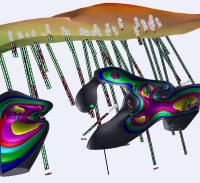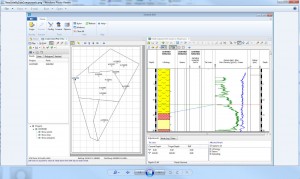
PERTH, AUSTRALIA and LONDON, UK – 23 May 2013: MICROMINE is pleased to announce the general release of Geobank 2013 and Micromine 2013, the latest versions of the company’s leading geological data management and
exploration and mine design solutions.
These major releases are the most significant MICROMINE releases with regards to the number and strength of new and enhanced features. Both releases continue MICROMINE’s tradition of producing intuitive software solutions that are easy-to-use and enhance user productivity.
Commenting on the new releases, MICROMINE CEO, Kevin Fitzpatrick, said ‘I am extremely proud of Geobank 2013 and Micromine 2013, and I am confident that our clients will realise the benefits the solutions have to offer. Like all of MICROMINE’s applications, these releases have been developed according to clients’ needs”.
“MICROMINE is committed to listening to its clients and developing solutions that are fit for purpose, intuitive, easy to use, logical and flexible. By re-investing a significant percentage of annual revenue into research and development, MICROMINE ensures its clients benefit from the latest technological advances with frequent, timely releases and updates.”
“In addition to the company’s Research and Development Program, MICROMINE invests a considerable amount of time and effort into its intensive Beta Testing Programs. These programs ensure latest software versions satisfy the needs of stakeholders when released to the market”.
Geobank 2013
Geobank 2013 includes a variety of new and enhanced features and benefits designed to improve data security, data accuracy and reliability, and reporting capabilities, facilitating increased data confidence.

These major releases are the most significant in the history of the applications with regards to the number and strength of new and enhanced features.
Geobank is a flexible, reliable and secure data management solution specific to the resource industry. The application provides a solution for the entire mining process by offering a framework for data capture, manipulation, synchronisation, validation, geological information, drillhole management, Quality Assurance and reporting.
Geobank Product Manager, Steve Bastick, said “MICROMINE’s Geobank Development Team has worked tirelessly over the past two years to develop new functionality that will further benefit our clients and the industry at large”.
“Geobank 2013 includes a new Advanced Reporting module designed to ensure all clients’ reporting requirements are achieved through the ability to configure, store and run complex reports. Major features include charting, data-binding, master-detail reports, sub-reports and a fully featured graphical end-user chart designer”.
“The solution also includes a new Data Model Framework module which allows users to build their data model quickly and easily through the provision of tools that support common data processes and data requirements. As a flexible solution that can be customised to clients’ needs, the framework can be developed according to a specific data model”.
“The module’s enhanced Data Transfer Framework increases data confidence and the quality of ‘live’ data by ensuring new data transferred into Geobank is validated before it is approved for inclusion in the production dataset. This separates new unapproved data from existing approved data, and allows users to configure how the new data will be merged with the existing data. Clients are provided full control of when and how data is replaced, overwritten, merged or added”.
Geobank 2013’s new Data Model Framework module also contains enhanced functionality regarding data validation, increasing the user’s confidence in the validity and quality of data through a more reliable and flexible validation process.
Other functionalities specific to this module include a new Audit Framework which increases data accountability by tracking the user name, date and time data is added and updated in the database, and new multi-lingual support which allows users to work in their preferred language.
Bastick concludes, “To further assist clients to reduce data errors and the time spent converting data between formats, Geobank 2013 includes a new Excel Importer. Data can be directly imported from Excel documents into databases, and multiple worksheets can be imported simultaneously from XLS and XLSX formats”.
Commenting on Geobank’s installation at Endocoal, an Australian coal exploration and development company, Charlie Lord, Endocoal Resource Geologist, commented “We chose Geobank as it fulfilled our data management, validation and reporting criteria. From our experience with Geobank, areas such as importing and exporting are easy, yet powerful. Our internal and external workflows are more sound and consistent. And most importantly, we have total confidence in the quality of our data”.
Micromine 2013
Micromine is a modular exploration and mine design solution which allows for the capture, management, and interpretation of critical mining and exploration data. Micromine 2013 follows on less than two years after the release of Micromine 2011.
Micromine Product Manager, Daria Lvova, explains “Consistent with all Micromine releases, the new features in Micromine 2013 focus on intuitive usability with enhanced workflow methodologies and logical processes. Productivity gains continue to be an area of focus through faster processing speeds, flexible import and export functions and computability with third-party applications”.
“The release includes two new modules; Stratigraphic Modelling and Implicit Modelling, along with many enhancements and further improvements to all other modules”.
Commenting on Micromine 2013’s user-friendly nature and new functionalities, Dr. Reso Kamberaj, CEO of JAB Resources and Micromine 2013 Beta Tester, explains, “I am a long-time user of Micromine for gold, platinum, chromite, copper and coal ore deposits. It is a very useful mining software application with an easy interface. It is also reliable and quick, especially in exploration where database changes/increases occur often”.
“The new modelling modules in Micromine 2013 are welcome additions. They are very efficient and enable ore modelling to be conducted quickly and accurately”.
Implicit Modelling – Using Micromine 2013’s new Implicit Modelling module, it is effortless to create and visualise the most complex wireframes. The Implicit Modelling module uses industry-standard radial basis (RBFs) to model grade shells, lithology boundaries, faults and surfaces. These wifeframes are readily displayed in Vizex, Micromine’s 3D environment, and are a valuable tool for finalising geological interpretations.
Stratigraphic Modelling – Micromine 2013 incorporates Seam Block Models (SBM) along with the associated seam modeling workflow. Seam modelling tools simplify the creation of SBMs, including splits, plies, overburden and interburden, even in stratigraphically complex areas. Micromine’s revolutionary stratigraphy display helps validate and visualise complex seam hierarchy. Additionally, Micromine’s stratigraphic modeling tools honour the original data, with smart tools that handle seam pinching and missing holes, producing a geologically correct model.
Rotated block models – Micromine 2013 supports rotated block models, which are models with axes that are not parallel to the coordinate system. One, two, and three dimension rotations are supported. Orientating the block to match the orebody means they are a better fit with reality, producing a small model and saving processing time and disk space. It also makes more geological sense and is closely aligned with modern reporting requirements to confirm continuity of grade and geology.
Python scripting – Due to increasingly complex mining processes and diverse user needs, a more sophisticated automation tool has been introduced within Micromine 2013, the Python programming language. With comprehensive mathematical tools, Python is one of the easiest programming languages to learn. Through Python, users can create their own solution while retaining Micromine’s ease-of-use.
Both solutions are being showcased with an international Launch Roadshow in Australia and the UK commencing in Perth at the Perth Convention Centre and London (23/5/2013) followed by Melbourne (28/5/2013), Sydney (29/5/2013) and Brisbane (20/5/2013).